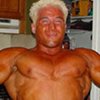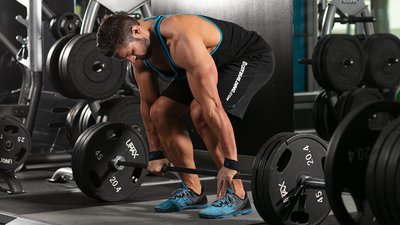When it comes to back training many people fall short on this large muscle group for many different reasons. The first being that you can't see your back when training it, which makes it harder to achieve that "mind muscle connection."
The second is that you can't really see your back when posing either, unless you have someone to take pictures of your back and view them after. This problem makes it harder to really focus on building it up to freak proportions.
This causes many bodybuilders to not give 100% intensity into this very large muscle group, and it all boils down to the fact that the bodybuilder cannot see it, so they figure why train it? And the worst part is about this scenario is that the bodybuilder's back is usually the determining factor whether you place well or not at bodybuilding contests.
Just as an example look at the Mr. Olympia contest, Jay can't touch Ronnie in the back department, and that is one of the main reasons as to why Ronnie will continue to hold the title for the seventh time leaving Jay to grab 2nd place.
Back is also one of the largest and complex muscle groups, which requires a high degree of focus and attention to detail while training it. When training back implementing a wide variety of exercises helps dramatically to make you back complete and well developed.
Separate Upper and Lower Back Exercises
What I mean by this concept is that when training the back you should start your workout focusing on the upper portion of your back (trapezius & latissimus dorsi), then moving on to the lower part of your back. I feel that this is a very good concept that many bodybuilders are beginning to use when training the back.
If you are using the deadlift in your back training I feel that these should be used in the early stages of your workout when you have the most energy to put into that compound exercise. When training upper back first, then moving on to lower back I do not feel you should use deadlifts at the end of your workout due to your energy output at this point.
When speaking of "upper back" the exercises that fall into this category are exercises that target that specific area of the back, mostly the lats and the upper middle portion of the back. So when picking exercises for the upper back you could choose from a wide range of high pulling exercises, pullovers, and pull-ups, exercises that work in this manner specifically target the upper portion of the back.
When speaking of specific "lower back" exercises you want to choose exercises that target the Christmas tree area (where the lower latissimus dorsi tie into the spinal erectors), and also the muscles that support the trunk area.
There are many power exercises that are used to target this area such as, deadlifts, heavy bent over rows, dumbbell rows, T-bar rows, incline bench rows, specific machines, low cable rows, and hyperextensions. All of these target one or multiple areas of the lower portion of the back.
In this article I will present a very effective back workout to specifically target the upper portion of the back during the beginning of the workout down to the lower portion of the back as the workout progresses
EXERCISE 1: Bent-arm barbell pullover
3-4 sets of 8-15 reps
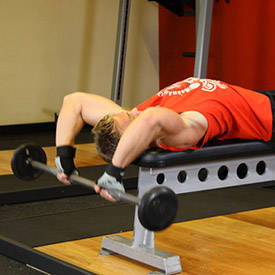
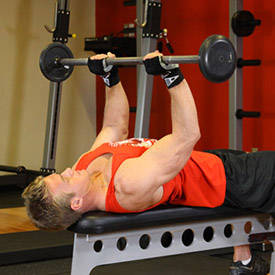
By using this grip, I feel you can use heavier poundage while stimulating the back more efficiently opposed to the traditional way.
This machine works very well as a first exercise for a back routine because of how it stretches your whole upper body, especially the lats. I feel that this exercise serves as a good warm up exercise to get your back ready for heavy lat pull downs and bent rows.
This exercise should be preformed for 3-4 sets with reps ranging from 15 down to 8. These should be performed using maximum intensity striving to use the heaviest weights possible while staying in that range.
EXERCISE 2: Straight-Arm Pulldown
3-4 sets of 8-15 reps


The next exercise for the upper back is pulldowns using a slightly wider than shoulder width grip (not at the bent portion of the lat pulldown bar). There is no additional benefit by extending your hands past the straight part of the lat pulldown bar, it just provides additional strain on your rotator cuffs, and this could lead to problems when you start using heavier weights.
I feel that this is a very effective exercise to use after performing the pullover machine. This exercise works the upper portion of the back very effectively, while really putting an emphasis on the lats. During this exercise you should stick out your chest and keep your lower back tight and straight to really squeeze the back while bringing the bar to your chest.
This exercise should be preformed for 3-4 sets for a rep range of 8-12. On any lat pull exercise (or any back exercise for that matter) form should never be sacrificed to use more weight on an exercise, strict form is the only way to effectively hit your back and feel it being worked.
EXERCISE 3: CLose-Grip Lat Pulldown
2-3 sets of 8-15 reps


Following the lat pulldowns I will perform an additional exercise to work the same area with a different variation. Close grip pulldowns, using two single hand cables preferred. These are more of an isolation exercise where less weight will be used, and the main importance will be to bring the handles all the way down and try to pull them apart for a maximum contraction.
Throughout this movement you should try to keep your back as straight as possible while pulling the handles to the upper portion of your chest. This will effectively target the middle region and the lower lats.
For this exercise since it is more used for a touch up for the previous exercise the sets can be reduced to 2-3 but the reps should be kept in the same range as before.
EXERCISE 4: Bent Over Barbell row
3-4 sets of 6-10 reps

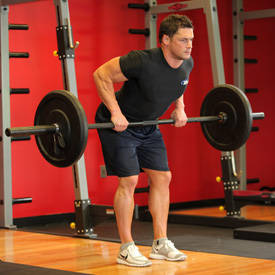
With the previous three exercises the upper portion of the back got directly stimulated very effectively so now the workout will begin to progress onto exercises that work the lower part of the back. After deadlifts the next best exercise to stimulate this area is the barbell bent over row.
Heavy bent rows will really thicken the overall back but especially the lower lats and spinal erectors. When performing these I usually suggest to put a 45lbs. plate on the ground where you will be standing, doing this will provide you with a greater range of motion while performing bent rows.
These are also a compound exercise so the heavy weights should be used on these to really thicken the back. The rep range should stay around 6-10 reps using maximum poundage while maintaining your form.
EXERCISE 5: One-arm dumbbell row
3-4 sets of 8-15 reps


After pounding the lower back with a heavy compound exercise like bent barbell rows I like to use an exercise that allows more isolation to the lower back and lats, such as dumbbell rows using an incline bench for a support.
All three of these exercises work very well to thicken the lower portion of the lats, and you should strive for a peak contraction at the end of each rep. Through out this movement you should really try to feel the back working on each rep.
On this exercise the weight should be kept somewhat moderate while trying to keep your reps in the 8-12 range for around 3-4 sets.
EXERCISE 6: Seated Cable Row
2-3 sets of 8-15 reps
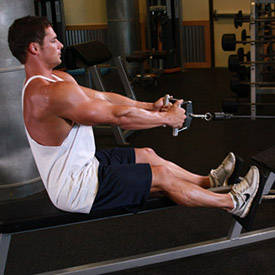
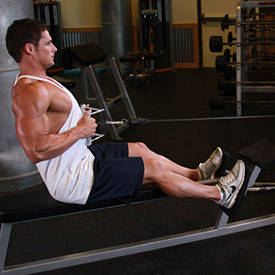
Another great exercise to work the lower lats is the seated low cable row machine. On these I feel that the best way to perform them is by using two single cables handles (like the close grip pulldowns) or by using an overhand close grip. Performing this exercise like this allows you to get a real nice contraction in the lower lats at the peak contraction of the exercise.
For this exercise the number of sets performed should be kept around 2-3 with the rep range the same as the previous exercises. For any back exercise, I feel that the form and the feel of the movement should never be sacrificed for the weight used on the exercise, which is a problem that is seen day in and day out in gyms all around.
EXERCISE 7: Back Extensions
2 sets
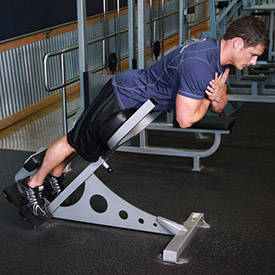
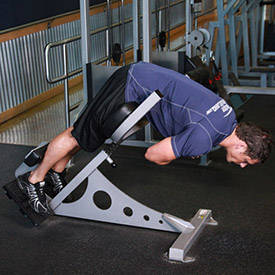
Many bodybuilders use no added weight with this exercise, and it really doesn't provide much for the back. What I like to do is grab a few plates and perform a long drop set, then when it is stripped to just body weight at the peak contraction squeeze your elbows back like you are performing a rear lat spread, and by doing this you can achieve a really tight contraction in the lower lats.
For this exercise, two sets are only needed with the last one a triple drop, and by doing this it should be more than enough to serve its purpose.
Variety Is Key To Back Training
When training the back, I feel variety is key if you are using volume style training. Notice in this back workout how there are seven different exercises discussed above, but on each one the total sets per exercise are never higher than four.
What I feel you should do is work quickly up to maximum poundage using moderate warm-ups then use the heaviest weight possible (while maintaining proper form) for your final one to two sets, and on choice exercises (such as isolation type movements) perform extreme training techniques such as drop sets, rest-pause sets, negatives, and forced reps.
By doing this, you will be able to hit your back from a variety of different angles while going all out with intensity on each one. The intensity you can generate for your work sets will dictate whether or not your workout is effective or not.
